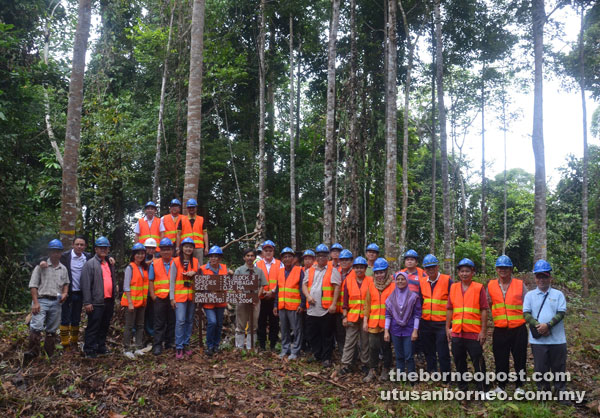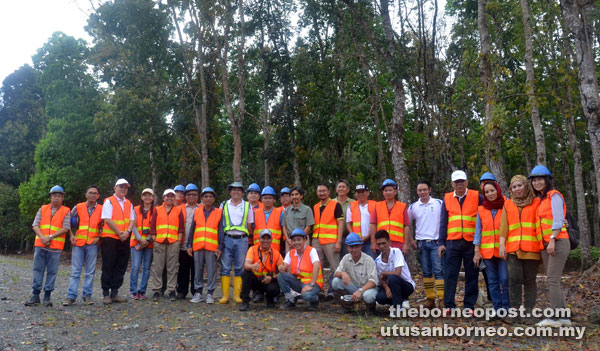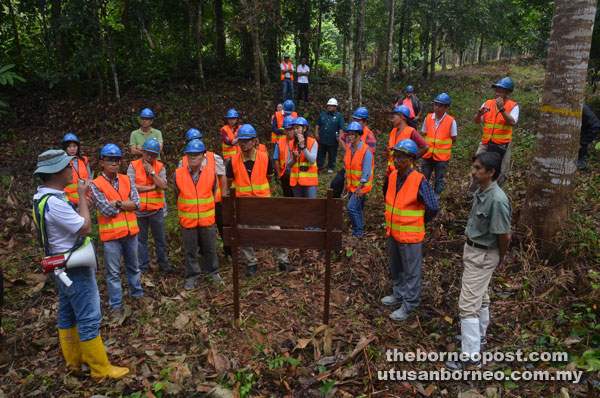KUCHING: Delegates from Sarawak Timber Industry Development Corporation (STIDC), Forest Department Sarawak, Ministry of Natural Resources and Environment and various forest management units (FMUs) from Sarawak made a one-day visit yesterday to KTS Plantation Sdn Bhd (KTSP) in Segaliud Lokan Forest Reserve (SLFR) FMU 19B.
A press statement said STIDC general manager Datu Sarudu Hoklai headed the delegation.
“The delegates are privileged to observe the application of the Sustainable Forest Management (SFM) principle, which is embodied in all aspects of the forest operation activities, especially the Reduce Impact Logging and forest rehabilitation programme,” said Sarudu.
“We have heard so much about KTS Plantation’s efforts and achievement on good forest governance. The evidence is for all to see.”
He also hailed the tripartite memorandum of understanding (MoU) between the Sabah Forestry Department (SFD), Universiti Malaysia Sabah (UMS), and KTSP, which he described as a smart way forward.
Sarudu said he appreciated the gesture of Sabah Forestry Department director Datuk Sam Mannan for allowing the visit to the two sites regarded as the flagship of good forest governance in Sabah.
Due to heavy rain, a visit to the harvesting area was cancelled.
However, a briefing on the Reduce Impact Logging (RIL) application was presented by district forestry officer (Sandakan) Fadzil Yahya, who highlighted that RIL’s main feature is the element of planning in all work processes, which is embodied in a document called the Comprehensive Harvesting Plan (CHP).
“The RIL standard is a live document which is progressively being refined to incorporate best scientifically proven advancements in forest harvesting which among others, aims at reducing residual damage on young seedlings while minimising negative impact on the environment,” said Fadzil.
The document has now been revised three times, he said, adding continuous training is the core factor for the successful implementation of RIL techniques as the operation requires a highly competent operator.
Institut Perhutanan Sabah (IPS) conducted the training.
A tour of the forest rehabilitation area demonstrated the potential of various high quality commercial species to be used in the forest rehabilitation programme such as Seraya Tembaga (Shorea leprosula), Kapur Paji (Dryobalanops lanceolata), and Urat Mata (Parashorea spp) from native species that have high market demand.
KTSP employs a unique forest rehabilitation approach called the High Production Corridor (HPC), which focuses on areas where harvesting impact is highest, centring on enhanced timber stocking and growth while rehabilitating the environment, which Fadzil acknowledged as an effective concept of achieving the two pronged objectives.
To date, KTSP has planted more than one million seedlings of 55 commercial species – pioneer, dipterocarp and non-dipterocarp.
Apart from the production activities, wildlife conservation has been given specific attention as demonstrated by the various wildlife monitoring programmes.
For this purpose, a total of 2,212 ha have been designated as wildlife corridors.
For the record, SLFR has been identified as one of the FMUs with the highest population of various rare, threatened and endangered species (RTE) in Sabah including the tembadau (Bos javanicus), clouded leopard (Neofelis nebulosa), orangutan (Pongo pygmaeus), proboscis monkey (Nasalis larvatus), and pigmy elephant (Elephas maximus).
Updating, identification and protection of various high conservation value forests (HCVFs) in SLFR is a routine exercise as the operation progresses.
The presence of both wildlife and various HCVFs in the reserve requires a unique management approach to ensure successful implementation of SFM in KTSP.
As the first private company in Malaysia from the forest industry certified with both
MC&I (Natural Forest) for Forest Management certification and MS ISO 14001 for Environmental Management System certification, KTSP is optimistic of achieving greater heights in forest management through research collaboration with SFD and UMS.
A tripartite MoU was signed between SFD, UMS and KTSP in 2016 for collaboration on forest operation and management research.
The tour is part of a three-day study visit in Sabah, which will end at the Sepilok Orang Utan Rehabilitation Centre.
Forest Department Sarawak officer Madeline George Pau was among the visitors.




